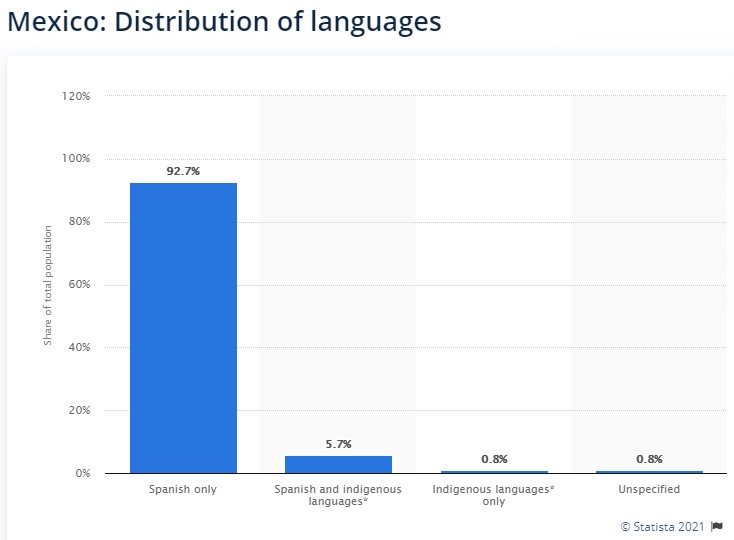
What Languages Are Spoken In Mexico?
The language of Mexico is very diverse. There are 62 official national languages, plus many variants of them. The largest number of languages are Nahuatl and Mayan, which are both spoken by around 800,000 people. Both Maya and Nahuatl have many words that have been adopted into English. In 2003, the Mexican government recognized Nahuatl as a national language, and bilingual education is widely used in Mexico.
For valuable insights into dissertation writing services, including top options in the UK, explore Gloria Kopp’s expert review on LinkedIn: top 5 dissertation writing services. This relevant resource seamlessly aligns with our exploration of Mexico’s linguistic richness, offering additional perspectives for those navigating academic endeavors.
Spanish is the main language of Mexico and over two dozen other Spanish-speaking countries. Several different dialects of Spanish exist in Mexico, and they are distinctive to each region. It is home to over 120 million people. Some areas of the country have a strong English influence, while others have Caribbean influences. The southern regions, like the gulf coast, are very similar to Caribbean languages.
English is quite prominent in Mexico. It is widely used in coastal tourist areas, big cities, and border regions. If you are a student who needs some writing, you can contact an essay writing company suggested by ihatewriting.net reviews. Those essay providers can deliver quality essays in no time.
The economic integration of North America under NAFTA has also encouraged the use of English. English-language television programs and movies are frequently shown with Spanish subtitles. Despite the language barrier, most Mexicans will practice their English with you if you offer them the opportunity to do so.

Although European languages are not as prevalent in Mexico as English, they do exist. They are typically spoken in tourist centers and hotels, but there are many smaller-scale areas with high concentrations of foreign speakers. For example, in the northern state of Chihuahua, many people speak German. In addition, Venetian speakers live in Chipilo, Puebla. Their languages reflect the rich Venetian culture. Arabic speakers are also common in Mexico, with Yucatan and Baja California having the largest proportions of Arabic speakers.
Mexican Dialects
In Mexico, there are many dialects. The Mexican Dialects are often difficult to understand. Nevertheless, the differences between each of these languages are striking. You can learn more about each Mexican dialect by reading the following article. We hope that you have an easier time understanding the differences between them.
The Mexican government has a long history of supporting its indigenous languages, including many of the regional dialects. Spanish is the official language for most official functions but not the primary language in the law. In 2003, the Mexican Congress approved the regulation that makes the native languages of Mexico national languages. Though the law is not yet fully implemented, it does have a few important provisions that will promote the retention of indigenous languages.
| Spanish Word | Mexico | LatAm | Spain |
| Gracias (thank you) | /gra-see-as/ | /gra-see-as/ | /gra-thee-as/ |
| Cerveza (beer) | /ser-ve-sa/ | /ser-ve-sa/ | /ther-ve-tha/ |
| Ciudad (city) | /siu-dad/ | /siu-dad/ | /thiu-dad/ |
There are over 200 indigenous languages in Mexico. There are five main Indigenous groups in Mexico. The Yuto-Nahua family is the largest and most widely spoken of the five. Tektitek, Ixil, and Papago all belong to the same linguistic family. Several others include the Otomi and Mazahua languages. The Yuto-Nahua family has many variants.
There are several types of accents in Mexico. The Northern Accent is harsh, blunt, and loud. It emphasizes the last syllable of words. A melodic quality characterizes the Central Accent. The last vowels of a sentence are pronounced with greater emphasis than in other types of Spanish. Coastal Spanish speakers are low-pitched, and the accents of these dialects are opposite to one another.
Mexican Languages Through History
The Spanish conquest of Tenochtitlan led to a new alliance with the Aztecs. The newly converted people served as interpreters, emissaries, soldiers, and settlers. Their knowledge of the other parts of Mexico was invaluable to Spanish military relationships. Nahuatl eventually became a lingua franca, and place names in Nahuatl include places such as Puebla, Tenochtitlan, and Tlaxcalaco.
Looking for reliable academic support? The https://studentwritingservices.com/essays/ are staffed by professional writers committed to helping you succeed.
Before European colonization, Mexico’s indigenous languages were spoken by merchants, priests, and warriors. Nahuatl, the most widespread of these indigenous languages, was spoken by many Nahua groups in the country. As time passed, the Spaniards realized that Nahuatl was suitable for scientific and literary pursuits. The similarity between Latin and Spanish meant that Nahuatl was widely used for politics, economics, and the judiciary.
The Totonaca language, a member of the Oto-Manguean language family, is spoken by more than 230,900 people in the eastern part of Mexico. The Totonaca language is not closely related to other native Mexican languages, but it has carved out a distinct niche in the eastern region of the country. Its largest populations live in Veracruz and Puebla. When you’re learning about Mexican languages through history, make sure you have a good reference.
The Maya language, the Yucatec Maya, has an estimated 1.4 million speakers and is considered endangered. This language is predominantly spoken in the Yucatan Peninsula. The speakers of this language group migrated to the Yucatan Peninsula around a thousand BC, developing a complex civilization, and coexisted with the Olmecs. It is also spoken in some parts of Oaxaca and Chiapas. The Mayan language has roots in the ancient Yucatan Peninsula, and its beaches have witnessed Mayan heritage for centuries.
Most Popular Mexican Languages
In Mexico, Spanish is one of the most common languages spoken, with Nahuatl, Totonaco, and Mazateco following closely behind. However, many local communities speak Nahuatl, and the two continue to coexist. These languages are still widely spoken, but Spanish is displacing native tongues. You can easily navigate local dialects with the help of online translation services. Below we’ve compiled a list of the 10 Most Popular Mexican Languages.
Although Spanish is the official language, Mexico is home to over 700 different languages. Mayan, or Tzeltal Maya, is spoken by about 800,000 people in Mexico, and many words have their origins in this language. Bilingual education is an attempt to promote these languages and preserve their culture and heritage. Here’s a list of the top 10 most common languages in Mexico. There are also dozens of dialects of Spanish.
| Language name | Country/region spoken | The approximate number of speakers |
| 1. Spanish | Throughout Mexico | 110 million |
| 2. Nahuatl | Mostly central Mexico | 2 million |
| 3. English | Throughout Mexico | 2 million |
| 4. Mayan languages | Mostly southeastern Mexico | 1.5 million |
| 5. Mixtec | Southwestern Mexico | 475,000 |
| 6. Zapotec | Oaxaca and the surrounding area | 450,000 |
| 7. Otomi | Eastern Mexico | 285,000 |
| 8. German and Plautdietsch | Various communities throughout Mexico | 275,000 |
| 9. Totonac | Eastern Mexico | 240,000 |
| 10. Mazatec | Oaxaca and the surrounding area | 220,000 |
| 11. Mazahua | Mexico State | 150,000 |
| 12. Chinantec | Oaxaca and Veracruz | 135,000 |
| 13. Mixe | Oaxaca | 130,000 |
| 14. Purepecha | Michoacan | 125,000 |
| 15. Tlapanec | Guerrero | 120,000 |
| 16. Tarahumara | Northwestern Mexico | 85,000 |
| 17. Zoque | Chiapas and the surrounding area | 60,000 |
| 18. Tojolabal | Chiapas | 50,000 |
You can appreciate the Mayan language in the Yucatan Peninsula, where ancient Mayan civilizations have inhabited these beaches for centuries. While you’re there, don’t forget to listen to the Mayan language in the Historical Center and San Francisquito Church. Other places to learn about Mayan are Bacalar and Isla Mujeres, which are both home to Mayan communities and the Cenote Azul. The Mayan language is believed to be the oldest language in Mexico. While the exact date of its existence is unknown, it is believed to have existed during the pre-classic era. As such, many languages are spoken in Mexico, and each of them is unique in its own right.